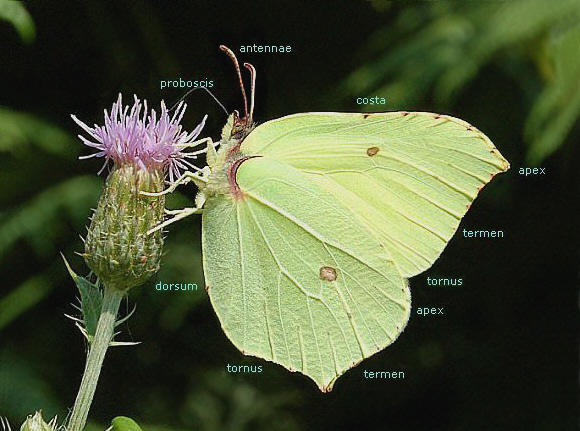 A female Brimstone Gonepteryx rhamni, seen here extending it’s proboscis to suck up nectar from a thistle flower. The pattern of raised wing veins ( venation ) can be seen clearly – Adrian Hoskins
A female Brimstone Gonepteryx rhamni, seen here extending it’s proboscis to suck up nectar from a thistle flower. The pattern of raised wing veins ( venation ) can be seen clearly – Adrian Hoskins
Venation
All butterflies and moths ( except Plume moths ) have 2 pairs of overlapping wings, each comprised of a very thin double membrane with rigidity supplied by a network of tubular veins which radiate from the base of the wings. The pattern of veins is different for every genus of butterfly, and is one of the main criteria used by taxonomists when classifying butterflies.
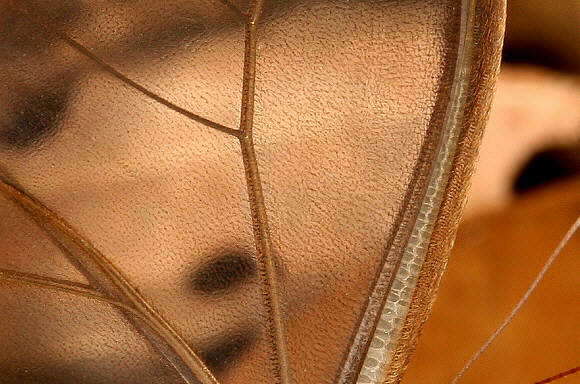
Vein structure of a transparent Satyrine butterfly Haetera piera – Tony Hoare
Scales
The wing membranes are transparent, but are partially or fully covered in a dust-like layer of tiny coloured scales. Each scale comprises of a flat plate arising from a single cell on the wing surface.
The scales vary considerably in shape, some being rectangular, while others are shaped like tear-drops or plumes. An individual scale might typically measure about 50 microns across ( 1/20 of a millimetre ) and be 100 microns long, although many are hair-like, and are very much longer.
There can be as many as 600 individual scales per sq millimetre of wing surface, although in certain genera such as Acraea, Aporia and Parnassius the density is considerably lower, giving the wings a translucent appearance. In some tropical genera such as Ithomia, Lamproptera and Cithaerias the scales are absent from large areas of the wings, resulting in almost complete transparency.
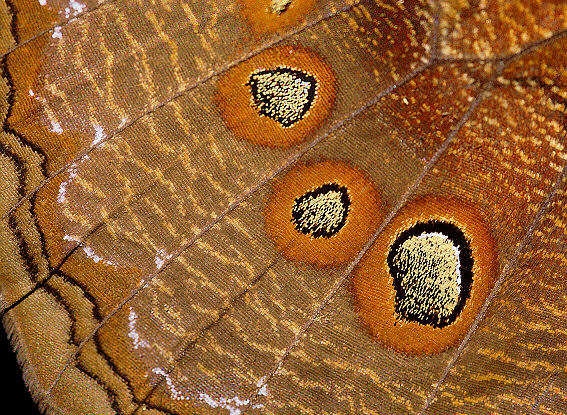
Catoblepia berecynthia ( Peru ), wing scales, magnification x10 – Adrian Hoskins
Pigmentary scales
Pigmentary scales are mostly flat. Their color is the result of the presence of melanins, pterins, and other chemical pigments, most of which are sequestered from the larval food plants and passed to the adult butterflies. The pigments account for the basic colors found in butterfly wings – black, red, and yellow. The juxtaposition of the various colored scales, and the amount of pigment they each contain, can create the illusion of additional colors such as orange, cream, and green.
In some species such as the Orange tip Anthocharis cardamines, the mottled green markings on the underside are an illusion caused by having a finely balanced mixture of yellow and black scales. Subtle variations in scale pigmentation and density can create illusions such as texture or shading, which help to give the wings of some butterflies a 3-dimensional appearance.
Structural scales
The fiery hues of Lycaena Coppers, the golden-yellow of Troides Birdwings, the glittering metallic greens of Caria Metalmarks, and the dazzling blues of the South American Morpho butterflies are produced by the refraction, diffraction, and interference patterns of light as it strikes or passes through the semi-transparent structural scales.
In the case of diffraction, light is broken up into lighter or darker bands after passing through a lattice of microscopic bubbles or slits within the scales. Refraction, on the other hand, is where light is broken up into its constituent rainbow colors as a result of passing through prismatic ridges on the surface of the scale.
Interference patterns are the result of light passing through clear layers of varying density, and being reflected back in such a way that the colors change according to the angle of view. Examples of such iridescent color are found in many butterflies, but are particularly striking in neotropical Doxocopa butterflies, where a band of color can change from electric blue to vivid turquoise or dazzling silver as sunlight strikes the wings at different angles.
Androconia
Androconia are found mainly on male butterflies.
They usually exist as slightly raised dark streaks or patches on the forewings and often have a mealy appearance. At the base of the androconia are tiny sacs containing scent (pheromones). The scent is disseminated via tiny hairs or plumes on the edges of the scales and used to entice females to copulate.
Male androconia can also take the form of tufts (e.g., on the hindwings of Morpho and Charaxes) or can be found in androconial folds such as found on the hindwings of Papilionidae or the costal fold of Pyrginae. In the Danaini and Ithomiini, they occur as “hair-pencils”.
These can either take the form of extrusible organs at the tip of the abdomen or occur as long “hairs” on the hindwings. In some species, e.g., Lycorea, the abdominal organ is brushed against androconia on the hindwings to collect pheromones. These are later disseminated by expanding the tufts in the presence of females.
Androconia can also occur as “stink-clubs” in the genital opening of female Battus, Parides, Troides, Ornithoptera, and Heliconius butterflies, and in certain moth families, e.g., Saturniidae, Lasiocampidae, and Lymantridae.
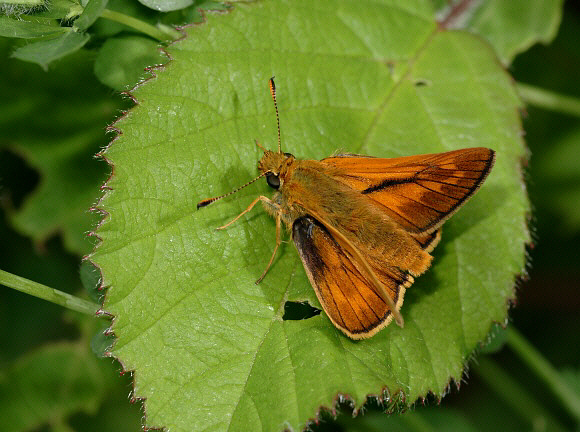 Large Skipper Ochlodes venata, England – Adrian Hoskins
Large Skipper Ochlodes venata, England – Adrian Hoskins
The dark diagonal patch on forewings of the male Large Skipper illustrated above are composed of hundreds of androconial scales. These disseminate pheromones that can be detected by females during courtship. As the male ages the strength of his pheromones diminishes, thus by analysing the strength of the pheromones a female can assess the age and virility of a potential mate.
Plume moths
Plume moths from the families Pterophorinae and Alucitidae have no wing membranes. Instead their fore and hind wings each consist of rigid veins edged with dozens of long thin feathery scales giving rise to the common name of “plume moths”.
There are 186 species of Alucitidae worldwide, many of which have only been discovered in the last 20 years. The name of the moth depicted below, Alucita hexadactyla translates as “20 fingers” but is a misnomer: Alucitidae actually have 24 feathery plumes ( some are hidden in the image below ).
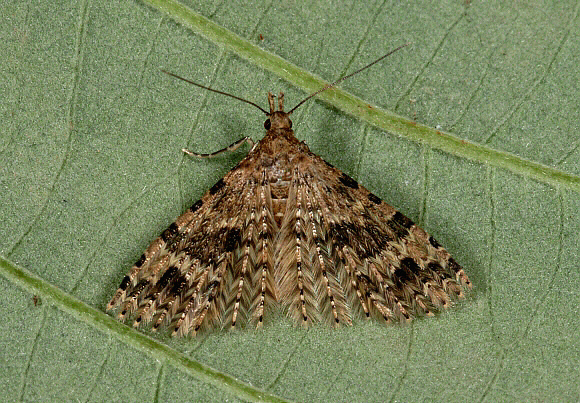 Many-plumed moth Alucita hexadactyla, Hampshire, England – Adrian Hoskins
Many-plumed moth Alucita hexadactyla, Hampshire, England – Adrian Hoskins
The Pterophorinae are similar anatomically but are distinguished by their long, spurred hind legs and the odd resting posture in which the wings are rolled up and held at an angle of 90 to the body.
 Common Plume moth Emmelina monodactyla ( Pterophorinae ), England – Adrian Hoskins
Common Plume moth Emmelina monodactyla ( Pterophorinae ), England – Adrian Hoskins
